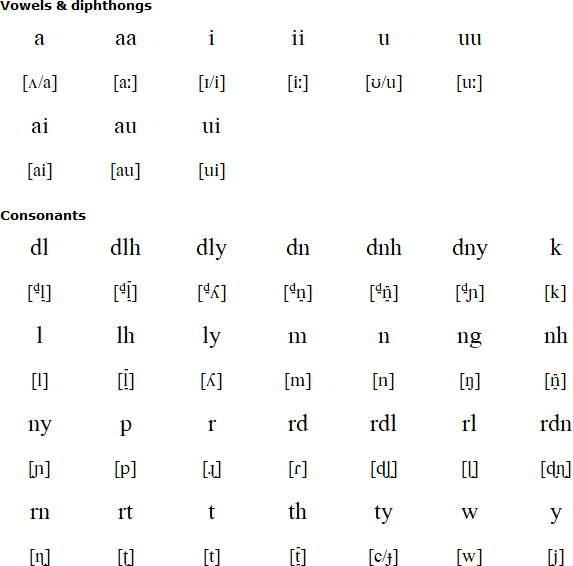Kaurna is a revived Pama-Nyungan language spoken in parts of South Australia by a small number of people. It was historically spoken in parts of the Adelaide Plains between Crystal Brook and Clare in the north, and Cape Jervis in the south, and just over the Mount Lofty range.
When Adelaide was first established in 1836 some of the colonists learnt the local Kaurna language. Two German missionaries, Clamor Schürmann and Christian Teichelmann, learned the language and published a grammar and vocabulary. In 1839 they opened a school at Piltawodli to teach the language, and they also translated parts of the Bible and other religious texts into Kaurna. In 1844 the Governor of the colony, George Grey, closed the school and banned the missionaries from preaching in Kaurna.
English became the sole language of the colony and Kaurna had died out as a community language by the 1860s. The person said to be last native speaker of Kaurna, Ivaritji, died in 1929.
Since 1990 efforts have been made to revive Kaurna using documentation compiled by the German missionaries. A small group, based at the University of Adelaide, that includes Kaurna people, teachers, linguists and other researches is working on this. The language was introduced in one school in 1992, and is now taught at all levels of education, including a Kaurna linguistics course at the University of Adelaide. A revised spelling system for Kaurna was introduced in 2010.

Download an alphabet chart for Kaurna (Excel)
Adelaid City Councilrlo tampendi, ngadlu Kaurna yertangga banbabanbalyarnedi (inbarendi). Kaurna meyunna yaitya mattanya Womma Tarndanyako.
Parnako yailtya, parnuko tappa purruna, parnuko yerya ngadlu tampendi. Yallaka Kaurna meyunna itto yailtya, tappa purruna, yerta kuma burro martendi, burro warriappendi, burro tangka martulyaiendi.
Adelaide City Council acknowledges that we are meeting on the traditional country of the Kaurna people of the Adelaide Plains.
We recognise and respect their cultural hertiage, beliefs and relationship with the land. We acknowledge that they are of continuing importance to the Kaurna people living today.
Source: http://linguistics.berkeley.edu/~survey/documents/survey-reports/survey-report-14.08-amery.pdf
Information about the Kaurna language and people
http://en.wikipedia.org/wiki/Kaurna_language
http://www.adelaide.edu.au/kwp/projects/language/
http://adelaidia.sa.gov.au/subjects/kaurna-language-kaurna-warra
https://www.adelaide.edu.au/kwp/language/spelling2010/
https://www.adelaide.edu.au/kwp/language/spelling/
Kaurna language learning series
http://www.youtube.com/channel/UChOOYOnJuEeydJK0QjN_Fpw
Alyawarr, Arrernte, Bundjalung, Dharawal, Dhuwal, Diyari, Djabugay, Djinang, Djinba, Gamilaraay, Gooniyandi, Gugadja, Guugu Yalandji, Guugu Yimithirr, Kala Lagaw Ya, Kalkatungu, Kaurna, Kuku Nyungkal, Kunjen, Kuuk Thaayorre, Lamalama, Martu Wangka, Ngaanyatjarra, Ngiyambaa, Nhangu, Noongar, Paakantyi, Pintupi, Pitjantjatjara, Warlpiri, Wemba Wemba, Wik-Mungkan, Wiradjuri, Yankunytjatjara, Yindjibarndi, Yolŋu
Languages written with the Latin alphabet
Page last modified: 23.04.21
[top]
You can support this site by Buying Me A Coffee, and if you like what you see on this page, you can use the buttons below to share it with people you know.

If you like this site and find it useful, you can support it by making a donation via PayPal or Patreon, or by contributing in other ways. Omniglot is how I make my living.
Note: all links on this site to Amazon.com, Amazon.co.uk
and Amazon.fr
are affiliate links. This means I earn a commission if you click on any of them and buy something. So by clicking on these links you can help to support this site.
[top]